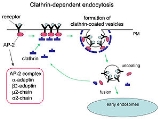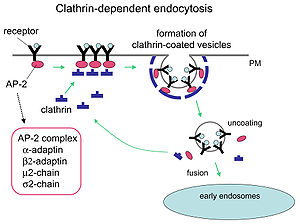
Receptor-mediated endocytosis
Encyclopedia

Clathrin
Clathrin is a protein that plays a major role in the formation of coated vesicles. Clathrin was first isolated and named by Barbara Pearse in 1975. It forms a triskelion shape composed of three clathrin heavy chains and three light chains. When the triskelia interact they form a polyhedral lattice...
-dependent endocytosis, is a process by which cells internalize molecules (endocytosis
Endocytosis
Endocytosis is a process by which cells absorb molecules by engulfing them. It is used by all cells of the body because most substances important to them are large polar molecules that cannot pass through the hydrophobic plasma or cell membrane...
) by the inward budding of plasma membrane vesicles containing proteins with receptor sites specific to the molecules being internalized.
Process
After the binding of a ligand to plasma membrane-spanning receptors, a signal is sent through the membrane, leading to membrane coating, and formation of a membrane invaginationInvagination
Invagination means to fold inward or to sheath. In biology, this can refer to a number of processes.* Invagination is the morphogenetic processes by which an embryo takes form, and is the initial step of gastrulation, the massive reorganization of the embryo from a simple spherical ball of cells,...
. The receptor and its ligand are then opsonized in clathrin-coated vesicles. Once opsonized, the clathrin-coated vesicle uncoats (a pre-requisite for the vesicle to fuse with other membranes) and individual vesicles fuse to form the early endosome
Endosome
In biology, an endosome is a membrane-bound compartment inside eukaryotic cells. It is a compartment of the endocytic membrane transport pathway from the plasma membrane to the lysosome. Molecules internalized from the plasma membrane can follow this pathway all the way to lysosomes for...
. Since the receptor is internalized with the ligand, the system is saturable and uptake will decline until receptors are recycled to the surface.
Common for biology.
Function
The function of receptor-mediated endocytosis is diverse. It is widely used for the specific uptake of certain substances required by the cell (examples include LDL via the LDL receptorLDL receptor
The Low-Density Lipoprotein Receptor is a mosaic protein of ~840 amino acids that mediates the endocytosis of cholesterol-rich LDL. It is a cell-surface receptor that recognizes the apoprotein B100 which is embedded in the phospholipid outer layer of LDL particles...
or iron via transferrin
Transferrin
Transferrins are iron-binding blood plasma glycoproteins that control the level of free iron in biological fluids. In humans, it is encoded by the TF gene.Transferrin is a glycoprotein that binds iron very tightly but reversibly...
). The role of receptor-mediated endocytosis is also well recognized in the downregulation of transmembrane signal transduction. The activated receptor becomes internalised and is transported to late endosomes and lysosomes for degradation. However, receptor-mediated endocytosis is also actively implicated in transducing signals from the cell periphery to the nucleus. This became apparent when it was found that the association and formation of specific signaling complexes is required for the effective signaling of hormones (e.g. EGF
Epidermal growth factor
Epidermal growth factor or EGF is a growth factor that plays an important role in the regulation of cell growth, proliferation, and differentiation by binding to its receptor EGFR...
). Additionally it has been proposed that the directed transport of active signaling complexes to the nucleus might be required to enable signaling as random diffusion
Diffusion
Molecular diffusion, often called simply diffusion, is the thermal motion of all particles at temperatures above absolute zero. The rate of this movement is a function of temperature, viscosity of the fluid and the size of the particles...
is too slow and mechanisms permanently downregulating incoming signals are strong enough to shutdown signaling completely without additional signals transducing mechanisms.
Experiments
Using fluorescent dyes to stain the plasma membrane, it is possible to follow the internalization of plasma membrane fragments by microscopy.Since the process is non-specific, the ligand can be a carrier for larger molecules. If the target cell has a known specific pinocytotic
Pinocytosis
In cellular biology, pinocytosis is a form of endocytosis in which small particles are brought into the cell—forming an invagination, and then suspended within small vesicles that subsequently fuse with lysosomes to hydrolyze, or to break down, the particles...
receptor
Receptor (biochemistry)
In biochemistry, a receptor is a molecule found on the surface of a cell, which receives specific chemical signals from neighbouring cells or the wider environment within an organism...
, drugs can be attached and will be internalized.
Specific Properties
- induction within minutes of exposure to excess ligand.
- the formation of these vesicles is sensitive to inhibition by wortmanninWortmanninWortmannin, a furanosteroid metabolite of the fungi Penicillium funiculosum, Talaromyces wortmannii,is a specific, covalent inhibitor of phosphoinositide 3-kinases . It has an in vitro inhibitory concentration of around 5 nM, making it a more potent inhibitor than LY294002, another commonly...
- the initiation of vesicle formation can be delayed/inhibited by temperature variations
See also
- Non-specific, adsorptive pinocytosisNon-specific, adsorptive pinocytosisNon-specific, adsorptive pinocytosis is a form of endocytosis, a process in which small particles are taken in by a cell by splitting off small vesicles from the cell surface. Cationic proteins bind to the negative cell surface and are taken up via the clathrin-mediated system, so the uptake is...
- PinocytosisPinocytosisIn cellular biology, pinocytosis is a form of endocytosis in which small particles are brought into the cell—forming an invagination, and then suspended within small vesicles that subsequently fuse with lysosomes to hydrolyze, or to break down, the particles...
- Phagocytosis
- ViropexisViropexisViropexis is the process by which different classes of viruses, particularly picornaviruses and papovaviruses, enter the host cell in which they will be able to replicate. The hydrophobic structures of the capsid proteins may be exposed after viral binding to the cell . These structures help the...
External links
- CytoChemistry.net- A lecture on RME with some nice pictures

